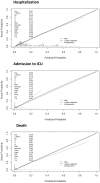Development and validation of a prognostic model based on comorbidities to predict COVID-19 severity: a population-based study
- PMID: 33349845
- PMCID: PMC7799114
- DOI: 10.1093/ije/dyaa209
Development and validation of a prognostic model based on comorbidities to predict COVID-19 severity: a population-based study
Abstract
Background: The prognosis of patients with COVID-19 infection is uncertain. We derived and validated a new risk model for predicting progression to disease severity, hospitalization, admission to intensive care unit (ICU) and mortality in patients with COVID-19 infection (Gal-COVID-19 scores).
Methods: This is a retrospective cohort study of patients with COVID-19 infection confirmed by reverse transcription polymerase chain reaction (RT-PCR) in Galicia, Spain. Data were extracted from electronic health records of patients, including age, sex and comorbidities according to International Classification of Primary Care codes (ICPC-2). Logistic regression models were used to estimate the probability of disease severity. Calibration and discrimination were evaluated to assess model performance.
Results: The incidence of infection was 0.39% (10 454 patients). A total of 2492 patients (23.8%) required hospitalization, 284 (2.7%) were admitted to the ICU and 544 (5.2%) died. The variables included in the models to predict severity included age, gender and chronic comorbidities such as cardiovascular disease, diabetes, obesity, hypertension, chronic obstructive pulmonary disease, asthma, liver disease, chronic kidney disease and haematological cancer. The models demonstrated a fair-good fit for predicting hospitalization {AUC [area under the receiver operating characteristics (ROC) curve] 0.77 [95% confidence interval (CI) 0.76, 0.78]}, admission to ICU [AUC 0.83 (95%CI 0.81, 0.85)] and death [AUC 0.89 (95%CI 0.88, 0.90)].
Conclusions: The Gal-COVID-19 scores provide risk estimates for predicting severity in COVID-19 patients. The ability to predict disease severity may help clinicians prioritize high-risk patients and facilitate the decision making of health authorities.
Keywords: COVID-19; admission to ICU; death; hospitalization; prediction model; severity.
© The Author(s) 2020. Published by Oxford University Press on behalf of the International Epidemiological Association.
Figures





Similar articles
-
Mortality and critical care unit admission associated with the SARS-CoV-2 lineage B.1.1.7 in England: an observational cohort study.Lancet Infect Dis. 2021 Nov;21(11):1518-1528. doi: 10.1016/S1473-3099(21)00318-2. Epub 2021 Jun 23. Lancet Infect Dis. 2021. PMID: 34171232 Free PMC article.
-
Prediction model and risk scores of ICU admission and mortality in COVID-19.PLoS One. 2020 Jul 30;15(7):e0236618. doi: 10.1371/journal.pone.0236618. eCollection 2020. PLoS One. 2020. PMID: 32730358 Free PMC article.
-
Community-acquired pneumonia severity assessment tools in patients hospitalized with COVID-19: a validation and clinical applicability study.Clin Microbiol Infect. 2021 Jul;27(7):1037.e1-1037.e8. doi: 10.1016/j.cmi.2021.03.002. Epub 2021 Apr 2. Clin Microbiol Infect. 2021. PMID: 33813111 Free PMC article.
-
External validation of six COVID-19 prognostic models for predicting mortality risk in older populations in a hospital, primary care, and nursing home setting.J Clin Epidemiol. 2024 Apr;168:111270. doi: 10.1016/j.jclinepi.2024.111270. Epub 2024 Feb 2. J Clin Epidemiol. 2024. PMID: 38311188
-
Severe COVID-19 infection: An institutional review and literature overview.PLoS One. 2024 Aug 20;19(8):e0304960. doi: 10.1371/journal.pone.0304960. eCollection 2024. PLoS One. 2024. PMID: 39163410 Free PMC article. Review.
Cited by
-
Estimating lengths-of-stay of hospitalised COVID-19 patients using a non-parametric model: a case study in Galicia (Spain).Epidemiol Infect. 2021 Apr 27;149:e102. doi: 10.1017/S0950268821000959. Epidemiol Infect. 2021. PMID: 33902779 Free PMC article.
-
General and COVID-19-Related Mortality by Pre-Existing Chronic Conditions and Care Setting during 2020 in Emilia-Romagna Region, Italy.Int J Environ Res Public Health. 2021 Dec 15;18(24):13224. doi: 10.3390/ijerph182413224. Int J Environ Res Public Health. 2021. PMID: 34948834 Free PMC article.
-
Development and validation of a prediction model for mechanical ventilation based on comorbidities in hospitalized patients with COVID-19.Front Public Health. 2023 Jul 14;11:1227935. doi: 10.3389/fpubh.2023.1227935. eCollection 2023. Front Public Health. 2023. PMID: 37522004 Free PMC article.
-
Association between multimorbidity and mortality in a cohort of patients admitted to hospital with COVID-19 in Scotland.J R Soc Med. 2022 Jan;115(1):22-30. doi: 10.1177/01410768211051715. Epub 2021 Oct 21. J R Soc Med. 2022. PMID: 34672832 Free PMC article.
-
A Framework for a Statistical Characterization of Epidemic Cycles: COVID-19 Case Study.JMIRx Med. 2021 Mar 18;2(1):e22617. doi: 10.2196/22617. eCollection 2021 Jan-Mar. JMIRx Med. 2021. PMID: 34077489 Free PMC article.
References
-
- World Health Organization. Coronavirus Disease 2019 (COVID-19) Situation Report-131. https://www.who.int/docs/default-source/coronaviruse/situation-reports/2... (31 May 2020, date last accessed).
Publication types
MeSH terms
LinkOut - more resources
Full Text Sources
Other Literature Sources
Medical

